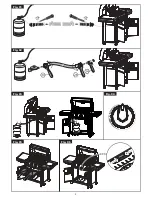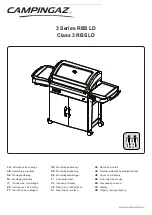
3
3
4. Fitting and Changing the Gas Cylinder
• Before connecting the appliance to a gas cylinder, ensure that the rubber seal on the regulator is in position and in good condition.
• Carry out this check each time you fit the appliance to a gas cylinder (see fig. 1).
• Blow out any dust from the cylinder opening to prevent possible blockage of the jet.
• Ensure the gas cylinder is fitted or changed in a well ventilated location preferably outdoors, away from any source of ignition such as
naked flames, and away from other people.
• Make sure that the gas cylinder is kept upright at all times. Hand tighten the regulator onto the cylinder until it is fully engaged.
• If there is a leak on your appliance (smell of gas), extinguish all sources of ignition in the vicinity of the appliance. If you wish to check
for leaks on your appliance, use soapy water which is applied to the suspected area. A formation of bubbles will indicate a gas leak.
Check that all the connections are securely fitted and re-check with soapy water. If you cannot rectify the gas leak, do not use the
appliance. Contact your local CADAC stockist for assistance.
• When changing a gas cylinder, first close the cylinder valve and then the appliance valve, making sure the flame is extinguished and
unscrew the regulator. Re-fit the regulator to a full cylinder following the same precautions as described above.
• After the appliance has been fully assembled, perform a gas leak test before operating the appliance.
• Make sure that the gas cylinder is kept upright at all times. Hand tighten the regulator onto the cylinder until it is fully engaged.
5. General Maintenance
• There are no predetermined maintenance intervals for this appliance.
• It is dangerous to use an appliance with a cracked or perished seal and/or hose. Inspect both seals and hose regularly and replace if
they are not in order before using the appliance.
• If the appliance was in use it will be hot. Allow to cool sufficiently before attempting any maintenance.
• CADAC Patio BBQ’s are fitted with spesific CADAC jets to regulate the correct amount of gas. Should the hole in the Jet become
blocked this may result in a small flame or no flame at all. Do not attempt to clean the Jet with a pin or other such device as this may
damage the orifice, which could make the appliance unsafe.
5.1.
Replacing a Blocked Jet
• Ensure that the cylinder valve is closed, then disconnect the appliance from the gas cylinder.
• Remove the grill plates. Remove the flame tamers to expose the burners. Remove the retaining screws of the affected burner.
• Remove the affected burner by lifting it out of its location taking care not to damage the control valve whilst doing so. This will expose
the Jet.
• Unscrew the blocked Jet with a suitable spanner and replace it with a new Jet. Do not use pliers on the Jet as they can cause damage,
making the Jet unusable or impossible to remove.
• Do not over tighten as this may damage the Jet. To re-assemble, reverse the above procedure.
5.2.
Replacement of Hose
• The hose length should not be less than 0.8m or exceed 1.2m. Check the date of manufacture on the hose and replace if it shows
signs of cracking or brittleness. Fitting of a hose is described in Figure 1b. Only an LPG hose that complies with local regulations may
be used with this appliance.
5.3.
Replacement of Regulator
• In South Africa the regulator used must be 2.8kPa and it must comply with SANS 1237.
• It is important that the connection between the regulator outlet and the low pressure hose is tight and that it is secured with a metal
hose clamp. Always check the joint for gas leaks as described in section 4 above.
GB
6. Troubleshooting
• A normal flame is blue and may have an orange or yellow tip. If the flame is completely yellow, it may be that the jet is not securely
fitted. Re-tighten the jet to ensure there is no gas leakage. An overfilled gas cylinder can also cause large yellow flames. If this is the
case the cylinder should be returned to the filling station and checked by weight.
• Check that the primary air supply apertures (holes) in the burners are clear and free of obstructions.
• If the flame power drops or the gas will not light, check that the gas cylinder still contains gas (shake to hear the noise made by a
liquid). If there is still gas, the jet might have become blocked or partially blocked.
• If you suspect a blocked jet, follow the instructions above.
503-0691 LEV7 (1192-08-ZA) Compact 2 - User Manual (SA).indd 3
2019/10/14 09:13:34


























